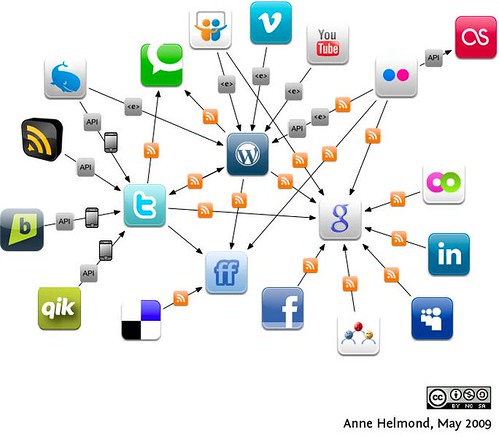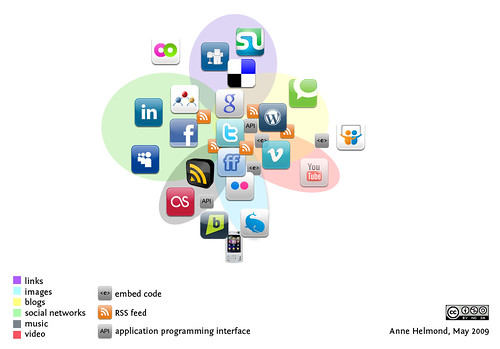My chapter for Networked: a (networked_book) about (networked_art), Lifetracing. The Traces of a Networked Life, is now officially online and open to comments. Thanks to Turbulence.org and and the National Endowment for the Arts for supporting my research.
Lifetracing. The Traces of a Networked Life
Identity on the web has changed by the assemblage of social software platforms, engines and users. Four major platforms for presenting the self online have developed over time: the homepage, the blog, the social networking profile and the lifestream. They each have their own specific way for presenting the self online. It should be mentioned that the shift has taken place from the centralized identity on the homepage to the distributed identity on a website with the lifestream.
The homepage is a self-secluded manually coded website containing its content on its own server. With the introduction of blog software the act of self publishing was made available to the public and the blog shows that it is part of a larger network with the embedding of external content from other services and platforms. In this era of the social web, the social networking profile has become a popular way to present the self online. The latest trend is the website containing a lifestream serving as an aggregation point for the distributed identity across various social media platforms.
The advent of the search engines has had a major impact on both the construction and the presentation of the online identity. Search engines do not only index the platforms identity is performed on, but they also organize and construct identity online. They act as a central point where identity performance is indexed. Since search engines have become the main entry point to the web, the idea of identity management has become very important. The case of Nina Brink, for example, shows how Search Engine Reputation Management tactics have been used to adjust online presence for the search engines.
The networked identity has proliferated as a result of the social media user recording the self online. Once content has been published online it becomes part of a larger network in which platforms can automatically exchange data and search engines can index data. The role of the user in this new situation is such that the user has become both content provicer and data provider. User data is used by the search engines for commercial gain but ironically it is also offered to the users in exchange for a ‘free’ account. Users gain access to their own statistics by providing their statistics. These statistics are used to measure the self and to show off the self on the social web.
Identity construction and identity performance have significantly changed since the advent of the engines, which calls for a reconsideration of identity. It can be argued that the assembly of platform, engine and user has constructed a new type of identity: Identity 2.0. This type of identity, placed within the period of Web 2.0, is always under construction, never finished, networked, user-generated, distributed and persistent.
Read the whole chapter of Lifetracing. The Traces of a Networked Life.
Official press release:
WE INVITE YOU TO PARTICIPATE . comment, revise, translate, submit a chapter http://networkedbook.org
Two years in the making, Networked: a (networked_book) about (networked_art) is now open for comments, revisions, and translations. You may also submit a chapter for consideration.
Please register and then Read | Write:
THE IMMEDIATED NOW: NETWORK CULTURE AND THE POETICS OF REALITY
Kazys Varnelis
http://varnelis.networkedbook.org
LIFETRACING: THE TRACES OF A NETWORKED LIFE
Anne Helmond
http://helmond.networkedbook.org
STORAGE IN COLLABORATIVE NETWORKED ART
Jason Freeman
http://freeman.networkedbook.org
DATA UNDERMINING: THE WORK OF NETWORKED ART IN AN AGE OF IMPERCEPTIBILITY
Anna Munster
http://munster.networkedbook.org
ART IN THE AGE OF DATAFLOW: NARRATIVE, AUTHORSHIP, AND INDETERMINACY
Patrick Lichty
http://lichty.networkedbook.org
TAGS: active, aethetics, aggregators, authenticity, authorship, BEN FRY, BEN RUBIN, BURAK ARIKAN, collaborative, communication, data, data mining, digital traces, distributed, DIY, EDUARDO NAVAS, everyday life, flow, GOLAN
LEVIN, identity, improvisation, Internet, JANET CARDIFF, JASON FREEMAN, JODI.ORG, JONATHAN HARRIS, latency, lifelogging, lifetracing, MANIK, mapping, MARK HANSEN, MARTIN WATTENBERG, MAX NEUHAUS, Mechanical Turk,
mediation, memory, music, narrative, NastyNets, NATHANIEL STERN, net art, network, NICK KNOUF, nonlinear, OLIVER LARIC, participation, performative, persistance, PETER TRAUB, platform, postmodernism, presentational, privacy,
prosumer, prosurfer, ranking, realism, reality, real-time, relational, remix, representation, research, RYBN, SCARLET ELECTRIC, SCOTT KILDALL, search engine, self, self-exposure, SHIFTSPACE.ORG, social networks, software, sousveillance, STEVE LAMBERT, storage, surveillance, tactical media, telepresence, THE HUB, THEY RULE, TrackMeNot, transmission, TV,
user-generated, visualization, web 2.0, webcam, widget, Wikipedia Art, YES MEN
BACKGROUND
“Networked” proposes that a history or critique of interactive and/or participatory art must itself be interactive and/or participatory; that the technologies used to create a work suggest new forms a “book” might take.
In 2008, Turbulence.org and its project partners — NewMediaFix, Telic Arts Exchange, and Freewaves – issued an international, open call for chapter proposals. We invited contributions that critically and creatively rethink how networked art is categorized, analyzed, legitimized — and by whom — as norms of authority, trust, authenticity and legitimacy evolve.
Our international committee consisted of: Steve Dietz (Northern Lights, MN) :: Martha Gabriel (net artist, Brazil) :: Geert Lovink (Institute for Network Cultures, The Netherlands) :: Nick Montfort (Massachusetts Institute for Technology, MA) :: Anne Bray (LA Freewaves, LA) :: Sean Dockray (Telic Arts Exchange, LA) :: Jo-Anne Green (NRPA, MA) :: Eduardo Navas
(newmediaFIX) :: Helen Thorington (NRPA, NY)
Built by Matthew Belanger (our hero!), http://networkedbook.org is powered by WordPress, CommentPress and BuddyPress.
Networked was made possible with funds from the National Endowment for the Arts (United States). Thank you.
We are deeply grateful to Eduardo Navas for his commitment to both this project and past collaborations with Turbulence.org.
Jo-Anne Green and Helen Thorington
jo at turbulence dot org
newradio at turbulence dot org


That was very cool and I was amazed of the pictorial representation.